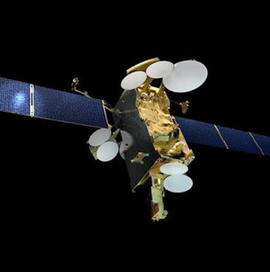Watch the SpaceX launch in the video player above.
SpaceX readied a Falcon 9 rocket for launch early Monday to boost a powerful SES communications satellite into orbit, providing direct-to-home video, high-speed data relay, broadband, maritime and aircraft connectivity across the Asia-Pacific region, Australia and the Middle East.
Using a previously flown “block 4” first stage and an upgraded block 5 second stage, the Falcon 9 was scheduled for liftoff from pad 40 at the Cape Canaveral Air Force Station at 12:45 a.m. EDT (GMT-4) Monday, the opening of a four-hour window. Forecasters predicted a 70 percent chance of acceptable weather with ground winds the only concern.
SpaceX had hoped to launch the SES-12 satellite last week, but a combination of factors, including additional second stage inspections, pushed the flight to Monday.
Because the first stage is an earlier-generation block 4 booster, it is limited to just two flights and no attempt will be made to recover the rocket after it propels the SES-12 relay station out of the dense lower atmosphere. Instead, the spent stage will simply crash back into the ocean.
“The launch vehicle is expendable,” said Martin Halliwell, chief technical officer for SES. “We won’t be attempting a landing. We’ve actually stripped everything off the first stage, there are no landing legs on board, so this is going straight into the ocean.”

An artist’s view of the SES-12 communications satellite.
SES
Without having to reserve propellants for a landing attempt, along with use of an upgraded block 5 second stage, the Falcon 9 is expected to boost the 11,800-pound SES-12 satellite into a “super-synchronous” transfer orbit, an ellipse with a high point of around 36,000 miles and a predicted low point of 182 miles.
The satellite’s lightweight ion propulsion system will take over at that point, slowly but efficiently boosting the relay station into a circular orbit 22,300 miles above the equator. At that altitude and equatorial orientation, satellites take 24 hours to complete one orbit and thus appear stationary in the sky as the Earth rotates.
“We get a lot of performance from this vehicle,” Halliwell said of the Falcon 9. “We’re actually going to an apogee around about 58,000 kilometers. So we’re going really high. We’re almost going to the limit of what we can do with the spacecraft.
“The good side of all this is it actually extends our (on orbit) life capability from 15 to 22 years. That’s enormous.”
SES-12 eventually will be maneuvered into its operational position at 95 degrees east longitude, co-located with SES-8. After extensive tests and checkout, the spacecraft is expected to enter operational service early next year.
Halliwell said SES-12, built by Airbus Defense and Space, combines features that would have required two spacecraft just a few years ago, providing direct-to-home television and other communications services through six beams covering an enormous area with multiple beams providing broadband connectivity.
“This is an incredibly flexible satellite that we’re putting into our fleet,” said John-Paul Hemingway, CEO of SES Networks. “By the time we’ve got this up there, we’re going to have nearly 70 satellites in our entire constellation. That’s pretty unique in the industry.”
Over the next five years in the SES-12 service region, SES expects 80 million more direct-to-home television viewers, “and obviously, this satellite will be a great way to deliver that content to the homes across all of Asia-Pacific,” Hemingway said.
Industry projections show a five-fold increase in aircraft use of broadband services over the next five years, a doubling of maritime users and up to a million or more additional “connected enterprises.”
And satellite internet service promises to grow at an equally astronomical rate.
“We believe there are around about a billion people in the Asia-Pacific market that still don’t have good connectivity through the devices you’re all holding in your hands right now,” Hemingway told reporters last week. “And satellite is one, and sometimes the only, way to connect 2G, 3G and 4G to those markets.
“If you take all those numbers together, this is really exciting for us,” he said.

